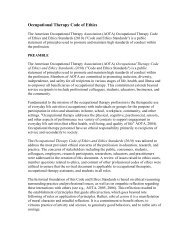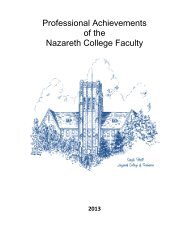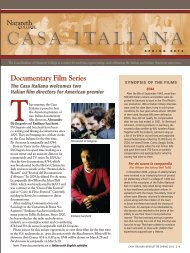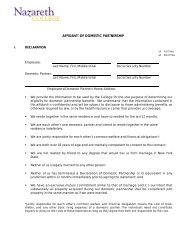Afternoon of Alterity - Nazareth College
Afternoon of Alterity - Nazareth College
Afternoon of Alterity - Nazareth College
You also want an ePaper? Increase the reach of your titles
YUMPU automatically turns print PDFs into web optimized ePapers that Google loves.
acclaimed critics to be representations <strong>of</strong> “categories <strong>of</strong> descent,language, law, and customs…identified as fundamental to medievalconcepts <strong>of</strong> race and ethnicity” (Huot 373), particularly whenspeaking in relation to those giants mentioned earlier. It is giantsspecifically that are used to characterize human differences and filethem away as “other” because “monstrous and savage though thesegiants are [they] nonetheless have clear human traits” (Huot 373),and these traits are very much similar to what was considered thenormative standard <strong>of</strong> the dominant (Western European) culture,but with fundamental differences in terms <strong>of</strong> “appearance [and]forms <strong>of</strong> behavior coded as unacceptable to European culture”(Huot 373) and therefore otherized and exoticized.While many Romantic texts (Ge<strong>of</strong>frey <strong>of</strong> Monmouth’s History <strong>of</strong>the Kings <strong>of</strong> Britain, featuring King Arthur, for instance) give us stories<strong>of</strong> characters, usually knights, attempting to defend themselves ortheir society from such “behavior that is savage, brutal, and utterlyantithetical to civilization” (Huot 375). However, one literary workin particular from the late Medieval English period, Sir Gawain andthe Green Knight, seems to give a clear alternative to assuage conflicts<strong>of</strong> dissonance. It is this avant-garde surprise ending which brings tolife a decidedly liberal and more humanistic solution to resolvingdifferences and sociocultural conflicts.A fight with a giant will most usually “culminate in a decapitation[because] giants always die in this severe manner” (Cohen 74) howeverin the aforementioned literary text, Sir Gawain and the Green Knight, abeheading occurs and the giant lives on. In fact, the way in which theplot concludes and the threat <strong>of</strong> the giant recedes is in the climacticending when the differences between Sir Gawain and Lord Bercilak,The Green Knight, are reconciled. The conflict exists though, in howthose dissimilarities <strong>of</strong> race, creed, culture, sexuality, etc., are putaside. Are they really forgotten? Does the protagonist (Sir Gawain)see the Green Knight in any different <strong>of</strong> a light at the end <strong>of</strong> the42 afternoons <strong>of</strong> alterity
















